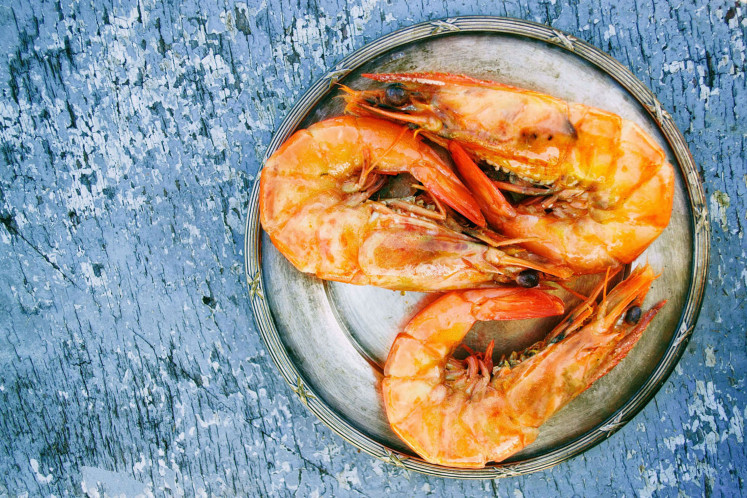Popular Reads
Top Results
Can't find what you're looking for?
View all search resultsPopular Reads
Top Results
Can't find what you're looking for?
View all search resultsChinese-Indonesians share their most memorable New Year’s feast
Food is a major part of Chinese New Year celebrations. Chinese-Indonesians talk about the meals that have stayed with them.
Change text size
Gift Premium Articles
to Anyone
F
ood is a major part of the Chinese New Year celebrations. Chinese-Indonesians talk about that meals they have shared for the holiday that have stayed with them.
One of the world's most widely observed holidays is the Lunar New Year, often known as the Chinese New Year. In these get-togethers, loved ones spend meaningful time with one another.
A particular highlight is unmarried young individuals eagerly anticipating to receive hóngbāo (紅包 translated as red envelope) stuffed with cash. However, eating is equally essential during the Sin Cia celebration (Chinese New Year).
During the Chinese New Year, the cuisine holds symbolic value. Guansheng Ma wrote in his 2015 publication “Food, eating behavior and culture in Chinese society” that the "symbolic significance of food eaten in religion is more important than the nutritional value."
There is unquestionably more profound symbolism in selecting food ingredients. For example, seaweed is a homonym of ‘rich’; noodle symbolizes health and long life and sticky rice balls mean a close-knit family.
Many Chinese Indonesians discuss the meals they consider the most symbolic hallmarks of the Chinese New Year.
Misua
Henokh Sukowijoyo, a 24-year-old student at the University of Sydney who majors in culinary arts, said that the Chinese New Year was one of the most anticipated celebrations in his family.
"It's even more special compared to Christmas, as most of my family members gather during the Chinese New Year," Henokh said while adding that the feast was also a significant part of the celebration.
He recalled how his paternal grandma frequently prepared misua (thin wheat vermicelli noodles that are salted and seasoned). Originally from Fujian, the noodle quickly became a favorite delicacy in other parts of Southeast Asia, including Cambodia, Malaysia, Vietnam and Brunei.
Many Chinese also believe that eating particularly long noodles will add years to their own lives.
According to the youngest of three siblings and Surabaya resident, the family recipe contained three main ingredients; chicken stock and meat, prawns and pork. For a vegetarian version of misua, chicken stock can be swapped out with vegetable broth and the rest of the seasonings with mushrooms and tofu.
For Henokh, it was even more special as his 79-year-old grandmother prepared everything herself. He shared that even the day before Chinese New Year celebration, his grandmother would wake up and start to cook at 4 a.m. to prepare the crispy wonton skins, boiled eggs and shrimps, among many other dishes, to liven the family’s feast.
"I would always go for seconds for the noodle soup," Henokh said while recalling his previous Chinese New Year celebrations in Malang city and his big family.
While living away from his grandmother, Henokh has tried to replicate the dish, but to this day, he has not been able to master it as Henokh's grandmother often uses her feelings to measure everything – cooking is not an exact science.
"I really salute my grandmother for her dedication to the family," he said.
Red chicken soup
David Susanto, the owner of the most popular restaurants in Malang, Widari, serves a number of authentic home-cooked Chinese-Indonesian dishs, including cap cai (mixed vegetables from Fujian province), koloke (sweet and sour chicken) and many other delicacies. The 35-year-old restaurateur shared that his favorite Chinese New Year dish was red chicken soup, also known as ang kak (red rice koji). Usually, he adds extra ginger for more warmth and a dash of peppery taste.
Chicken is an important ingredient in the Chinese New Year feasts as a whole chicken represents the family's togetherness and joy.
“It tastes like home,” David said, remembering his grandmother, who passed away eight years ago.
The father of two shared that the soup was considered a humble dish because it only had two ingredients: free-range chicken and red rice koji. It is believed that red rice koji is good for health, where it is thought to invigorate the body, aid digestion and remove “blood blockages'. David's grandmother used to prepare everything at dawn, as she needed to prepare for the family dinner and the restaurant she owned to welcome customers who were also celebrating the Chinese New Year.
"It's an inherited recipe. I couldn't tell where my grandmother learned how to cook the dish, but my children love it as well," David said, remembering his grandmother's legacy of the recipes.
Although his family does not cook the dish as often as it used to, the dish remains close to his heart, noting that it was almost nostalgic as there was no dish like his grandmother's.
"We used to sit and eat all of [her dishes], so it's hard to describe the taste in words," David said.
“We even tried to cook it because my children were asking for it,” he added.
Steamed prawn
Jennifer Makaria, who currently resides in Singapore, said that her favorite Chinese New Year food was steamed prawns doused in her uncle's special sauce. Jennifer divulged that her uncle has a special sauce recipe for the best prawn dipping sauce.
Jennifer further shared that nothing could beat the taste consistency of his uncle’s dish. The oldest of two siblings shared that she was a picky eater and that familiarity with a dish was key to her palate.
Chinese New Year celebrations are complete with the prawn dish. In Cantonese, the word for prawn is pronounced “hā”, which sounds like a burst of laughter, and many individuals believe that eating prawns during a new year celebration will bring happiness to the entire family for years to come. There is even a saying that the bigger the prawn, the better it is.
For the last eight years since Jennifer first settled in Singapore, she has always attended the annual Chinese New Year dinner at her aunt and uncle's. Usually, she would go to her uncle’s house at 5 p.m., just when he started to prepare the meal. The 24-year-old continued that she lacked the proper words to describe how mouth-watering the dish was.
Jennifer remarked, "Simple dishes that can remind me of home and family gatherings make it even more precious."
Steamed fish
Ria Suriani, who currently resides in Jakarta and works in a private sector company in the mining industry, shared that her favorite Chinese New Year dish was the steamed fish with homemade sauces prepared from ginger, garlic, chili, soy sauce and oyster sauce.
The 32-year-old recalled that she had helped her mother in the kitchen ever since she was in primary school. As a Chinese-Indonesian, fish is another staple dish during the Chinese New Year. In Mandarin, the pronunciation for fish, “yú”, is reminiscent of the sound of the word for wish and abundance. Hence, fish symbolizes wealth and happiness.
But aside from the meaning of the dish, the time she spent with her mother cooking the dish is priceless as a chance for familial bonding chit-chat during the course of the process, as Ria rarely sees her mother, who lives in Jambi. Aside from preparing the steamed fish, Ria and her mother usually spent hours preparing other dishes, such as steamed prawns, dumplings and many others.
"It's just a different touch of feeling, from being able to help your mother to indulging in the dish with the family," Ria added that there was no food that tasted like her mother's cooking, which feels like home in a way that Ria finds hard to describe.
Ria added that she had not been able to reunite with her mother due to COVID-19 travel restrictions. This year, it would be the first chance for Ria, after over two years, to celebrate Chinese New Year together with her family in Jakarta.
"I'm really looking forward to it, there's nothing that can replace the family's togetherness," Ria closed.












